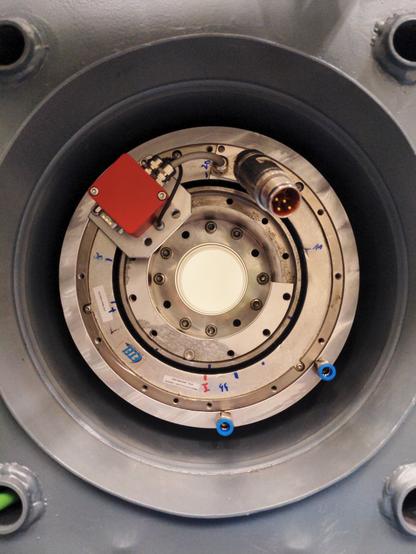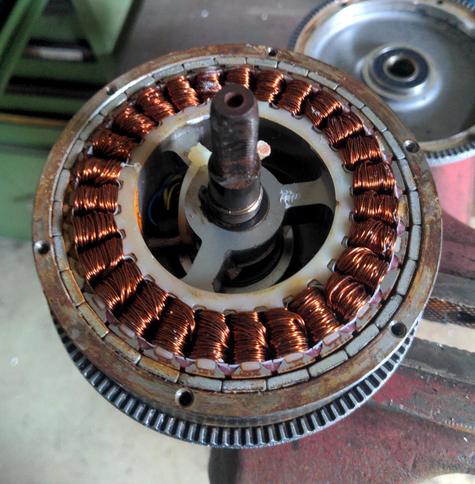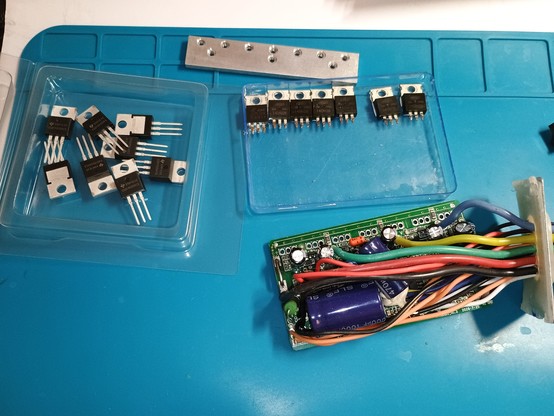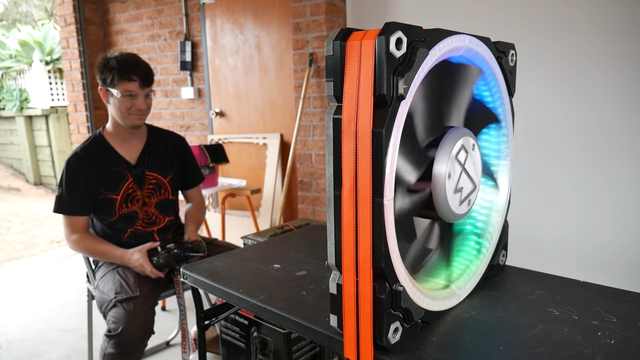#bldc
M5Stack Roller485 Robot Testing Phase
https://peertube.otakufarms.com/videos/watch/f62b0c35-e8c6-44b5-82b4-054a5e76c2b2
Сколько роботов можно испечь на кухне?
Привет, Хабр! Хочу поделится личным опытом в DIY роботостроении. Что можно уже сейчас сделать с доступными современными технологиями CAD проектирования, 3д печати, прототипирования моделей в симуляторах физики, новыми функциональными языками программирования а также паяльником, отверткой и желанием постигать что то новое. Так сколько?
https://habr.com/ru/articles/872006/
#ардуино #роботы #робототехника #slam #симулятор #mecanum #cad #diy #bldc #сервопривод
I have shared the slides for some of my best technical presentations here:
https://www.slideshare.net/lalitpatnaik/presentations
#PowerElectronics #PowerSupplies #ElectricDrives #BLDC #BatteryCharging #BattChat #RadTol
О способах определения магнитных полюсов. Визуальное объяснение
Статья о способах определения магнитных полюсов у соленоидов и электромагнитов различной формы, с привязкой к статору электродвигателя, как пример более сложного электромагнита. Текст направлен на осмысленное понимание создания и использование магнитных полей в электротехнических устройствах. Эта статься с упором на простоту и визуальное объяснение материала, без лишнего усложнения.
https://habr.com/ru/articles/863248/
#BLDC #статор #Электродвигатель #магнитное_поле #электрический_ток #магнит
Разработка контроллера управления шаговыми моторами
Разработка контроллера шагового двигателя Высоковольтный драйвер шагового мотора. Схема почти полностью на китайских элементах. Питание схемы 75В. Создание дешёвого проекта во время кризиса полупроводников в 2022. Почитать
https://habr.com/ru/articles/770282/
#слономышь #bldc #Step_motor #драйвер_двигателей #драйвер_мотора #Драйвер_шаговика #драйвер_шагового_двигателя #tivac #tiva_c #tm4c123g
Универсальный контроллер моторов на ARM Cortex-M85. Трассировка
Новейшее семейство микроконтроллеров RA8M1 просится быть использованным в умном электроприводе. Вычислительная мощь ядра ARM Cortex-M85 (480 МГц) позволяет легко управлять на нашей плате одновременно двумя PMSM/BLDC или тремя DC коллекторными моторами с использованием алгоритмов машинного обучения и еще оставляет ресурс для комплексной удаленной диагностики в реальном времени. Добавим сюда IoT на ESP32-С6, дисплей, интерфейсы энкодеров, полевые шины и в результате получаем универсальный контроллер моторов.
The World's First Screwbike! Video goes out 7am UK time Tuesday on YouTube.
Some chunky 3D Prints with Lulzbot 1.2mm nozzles and 3DFuel Pro PLA+, and some mounts for ODrive S1 drivers and motors. Should have about 6KW of power!
#machine #3dprinted #bldc #brushless #mechanical #testing #project
OpenMower: Open Source Robotic Lawn Mower With RTK GPS
Robotic mowers are becoming a common sight in some places, enabled by the cost of motors and the needed control electronics being much lower, thanks to the pace of modern engineering. But, in many cases, they still appear to be really rather dumb, little more than a jacked up bump-and-go with a spinning blade. [Clemens Elflein] has taken a cheap, dumb mower and given it a brain transplant based around a Raspberry Pi 4 paired up with a Raspberry Pi Pico for the real time control side of things. [Clemens] is calling this OpenMower, with the motivation to create an open source robot mower controller with support for GPS navigation, using RTK for extra precision.
The donor robot was a YardForce Classic 500, and after inspection of the control PCB, it looks like many other robot mower models are likely to use the same controller and thus be compatible with the openmower platform. A custom mainboard houses the Pi 4 and Pico, an ArduSimple RTK GPS module (giving a reported navigational accuracy of 1 cm,) as well as three BLDC motor drivers for the wheels and rotor. Everything is based on modules, plugging into the mainboard, reducing the complexity of the project significantly. For a cheap mower platform, the Yardforce unit has a good build quality, with connectors everywhere, making OpenMower a plug and play solution. Even the user interface on top of the mower was usable, with a custom PCB below presenting some push buttons at the appropriate positions.
Motor control is courtesy of the xESC project, which provides FOC motor control for low cost, interfacing with the host controller via a serial link. This is worth looking into in its own right! On the software side of things, [Clemens] is using ROS, which implements the low level robot control, path planning (using code taken from Slic3r) as well a kinematics constraints for object avoidance. The video below, shows how simple the machine is to operate — just drive it around the perimeter of lawn with a handheld controller, and show it where obstacles such as trees are, and then set it going. The mower is even capable of mowing multiple lawns, making the journey between them automatically!
Robotic mower projects are not new around here, here's the mysterious TK with an interesting take, another using RTK GPS for good (or possibly bad) and quite probably the jankiest one we've seen in a while, which uses a LoRa base-station to transmit RTK corrections. We'd recommend keeping well away from that last one.
#robotshacks #autonomousmower #bldc #gps #kicad #raspberrypi4 #raspberrypipico #rtk
3D-Printed Parts Let You Assemble Your Own Biggest Fan
It's getting close to the time of year when we need to start carefully vetting projects here at Hackaday. After all, nobody likes to get punked by an early April Fool's joke. But as silly as this outsized PC fan looks, it sure seems like a legit build, if a bit on the pointless side.
Then again, perhaps pointless is too harsh a word to use. This 500-mm fan is by [Angus] over at Maker's Muse, and it represents a lot of design work to make it buildable, as well as workable and (mostly) safe. Using both CNC-cut MDF and printed parts, the fan is an embiggened replica of a normal-sized case fan. The fan's frame had to be printed in four parts, which lock together with clever interlocking joints. Each of the nine blades locks into a central hub with sturdy-looking dovetails.
And sturdy is important, as the fan is powered by a 1,500 Watt brushless DC motor. With a 4:1 reduction thanks to a printed gear train, the fan spins at around 3,300 RPM, which makes a terrifying noise. There's a little bit of "speed-wobble" evident, but [Angus] managed to survive testing. The fan, however, did not -- the 3D-printed gears self-destructed after a full-speed test, but not before the fan did its best wind tunnel imitation. And the RGB LEDs looked great.
This one reminds up of something we might see [Ivan Miranda] come up with. In fact, his super-sized 3D printer might have been just the thing to shorten [Angus]' print times.
#3dprinterhacks #3dprinting #bldc #blower #dovetail #esc #fan #leds #rgb
Haptic Smart Knob Does Several Jobs
A knob is a knob, a switch is a switch, and that's that, right? And what about those knobs that have detents, set in stone at the time of manufacturing? Oh, and those knobs that let you jog left to right and then snap back to center -- that can't be modified…right? Well, you likely know where this is going, and in the video below the break, [scottbez1] shows off a new open source haptic input knob that can be all of these things with just some configuration changes!
The list of possibilities is long: virtual snap points, virtual spring loading, virtual detents, virtual end points. It's a virtual smörgåsbord of configuration options that make this haptic smart knob a one stop shop for all of your knob needs. This is all possible because the knob contains a high resolution magnetic encoder chip that has a single degree resolution. The sensor is coupled, through software, to a brushless DC motor. The round LCD gives visual feedback as well.
As [Myself] on the Hackaday Discord channel noted, having configurable spacing and strength for detents, springs, and stops, is nothing short of incredible. Being able to reconfigure the knob at-will means that it can become context sensitive. It's wonderfully unique and it's open source, so you can make your own with the information available at GitHub.
And according to its creator, the only thing the Haptic Smart Knob _can 't _do is do your taxes or blend your margarita. Well, it's open source, so perhaps some of our more enterprising readers can submit just the right pull request.
This isn't Hackaday's first Motorized Volume Knob feature, but it might be one of the neatest we have seen so far. Thanks to [mattvenn] on the Hackaday Discord server for the great tip!
#hardware #peripheralshacks #bldc #haptic #hapticinput #inputknob #jogwheel #lcd #scrollwheel #straingauge
Differential Drive Doesn’t Quite Work As Expected
Placing two motors together in a shared drive is a simple enough task. By using something like a chain or a belt to couple them, or even placing them on the same shaft, the torque can be effectively doubled without too much hassle. But finding a way to keep the torque the same while adding the speeds of the motors, rather than the torques, is a little bit more complicated. [Levi Janssen] takes us through his prototype gearbox that attempts to do just that, although not everything works exactly as he predicts.
The prototype is based on the same principles as a differential, but reverses the direction of power flow. In something like a car, a single input from a driveshaft is sent to two output shafts that can vary in speed. In this differential drive, two input shafts at varying speeds drive a single output shaft that has a speed that is the sum of the two input speeds. Not only would this allow for higher output speeds than either of the two motors but in theory it could allow for arbitrarily fine speed control by spinning the two motors in opposite directions.
The first design uses two BLDC motors coupled to their own cycloidal drives. Each motor is placed in a housing which can rotate, and the housings are coupled to each other with a belt. This allows the secondary motor to spin the housing of the primary motor without impacting the actual speed that the primary motor is spinning. It's all a lot to take in, but watching the video once (or twice) definitely helps to wrap one's mind around it.
The tests of the drive didn't go quite as planned when [Levi] got around to measuring the stall torque. It turns out that torque can't be summed in the way he was expecting, although the drive is still able to increase the speed higher than either of the two motors. It still has some limited uses though as he notes in the video, but didn't meet all of his expectations. It's still an interesting build and great proof-of-concept otherwise though, and if you're not clear on some of the design choices he made there are some other builds out there that take deep dives into cycloidal gearing or even a teardown of a standard automotive differential.
Thanks to [Kelvin Ly] for the tip!
#3dprinterhacks #enginehacks #bldc #cycloidal #differential #gear #gearbox #highspeed #planetary #prototype #testing #twomotors




